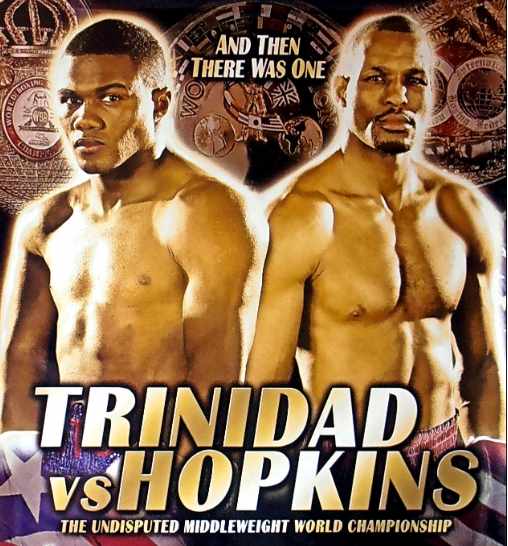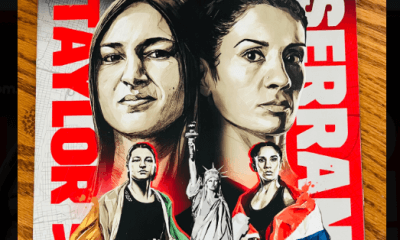Featured Articles
The Hauser Report: From 9/11 to COVID-19

The Hauser Report: From 9/11 to COVID-19
Felix Trinidad and Bernard Hopkins were supposed to fight at Madison Square Garden on September 15, 2001. Then 9/11 intervened. After Trinidad-Hopkins was postponed, I visited an empty Madison Square Garden on the night that would have been.
“Tonight was a perfect mid-September evening,” I wrote. “Clear skies, temperature in the low sixties, a hint of autumn in the air. No events were listed on the Garden marquee; just the digital image of an American flag at half-mast. This was to have been ‘ground zero’ tonight. Bernard Hopkins versus Felix Trinidad for the undisputed middleweight championship of the world. Screaming partisans had been expected to turn Madison Square Garden into a sea of red, white, and blue flags. Puerto Rican flags. A half-dozen uniformed New York City cops stood outside the employees entrance at the corner of Eighth Avenue and 33rd Street. Other cops were sprinkled in and around Penn Station, which lies beneath the Garden. The main arena was dimly lit, its floor still covered with ice put in place for New York Rangers practices earlier this week. Eventually, things will return to normal in America, although the definition of ‘normal’ will change.”
I thought about that night this week. Fight cards were scheduled to be promoted by Top Rank at Madison Square Garden on March 14 and March 17. The first of these was to have featured U.S. Olympian Shakur Stevenson. The second – a St. Patrick’s Day special – would have been headlined by Irish Olympian Michael Conlan. Then COVID-19 (an acronym for “coronavirus disease 2019”) intervened.
The 1918 influenza pandemic, commonly referred to as the Spanish flu, infected an estimated 500 million people (roughly 25 percent of the world population at that time). No firm numbers are available, but it’s estimated that the illness was responsible for 50 million deaths.
The population of the United States in 1918 was 106 million. An estimated 670,000 Americans died as a consequence of contracting the Spanish flu. That’s equivalent to 2.1 million deaths in the United States today.
Most fatalities from influenza occur in infants under the age of two and adults over age 70. The Spanish flu was unique in that almost half of the 670,000 deaths in the United States were of men and women between the ages of 20 and 40.
Most viruses abate during the warm summer months. The 1918 Spanish flu came in two waves. The second wave, which swept over America in October, was deadlier than the first.
The first cases of COVID-19 were traced to China in November 2019. On March 11, 2020, the World Health Organization formally classified the spread of the disease as a “pandemic.” As of this writing (March 14), more than 145,000 cases in 130 countries resulting in 5,400 deaths have been confirmed. That’s a death rate of 3.7 percent as compared to the one-tenth of one percent death rate for more common forms of influenza.
There have been more than 2,600 confirmed cases of COVID-19 resulting in 56 deaths in the United States.
All of these numbers are expected to rise.
Efforts to combat the spread of COVID-19 have resulted in travel restrictions, the quarantine of geographic regions, event cancellations, and the shutdown of businesses. Schools and other institutions have closed their doors. Religious services have been canceled. Millions upon millions of people have changed their habits. Many are now working from home.
This is the new normal.
The sports world has ground to a halt.
Team rosters in baseball and other sports were depleted during World War II but the games went on. Champions like Joe Louis reported for military duty but professional boxing continued.
This is different.
On March 11, the National Basketball Association announced that it was canceling all games until further notice. That same day, the NCAA announced that the men’s and women’s basketball championship tournaments would be played with no one other than essential personnel allowed in the arenas. One day later, the NCAA announced that “March Madness” and all other NCAA winter and spring championship events had been canceled in their entirety.
On March 12, Major League Baseball announced that it was canceling all remaining spring training games and delaying the start of the regular season (scheduled for March 26) by at least two weeks.
On March 13, officials at Augusta National Golf Club announced that The Masters, scheduled for April 9 through April 12, had been postponed.
When the NBA, “March Madness,” Major League Baseball, and The Masters shut down, people pay attention.
Boxing matches in the United States and around the world have been canceled.
On March 11, governor Gavin Newsom announced that California public health officials had advised him that, until at least the end of March, gatherings of more than 250 people should be postponed. One day later, the California State Athletic Commission announced that all combat sports events in the state through the end of March had been canceled.
In New York, the Metropolitan Museum of Art, Metropolitan Opera, Carnegie Hall, and New York Philharmonic Orchestra announced temporary closures. Broadway shows were suspended through at least April 12. For the first time since its inception 258 years ago, the St. Patrick’s Day Parade was postponed.
As for the Shakur Stevenson and Michael Conlan fight cards . . . On March 12, Top Rank issued a press release that read in part, “Due to the coronavirus pandemic and to ensure the health and safety of boxing fans and the fight participants, the March 14 and March 17 events at Hulu Theater at Madison Square Garden will proceed without spectators. The only individuals granted access to the events will be essential production and support staff in addition to fighters and necessary team members and credentialed media. Both events will still be shown live on their respective ESPN platforms.”
The plan to hold the fights without spectators in the arena evoked the memory of baseball great Willie Keeler who, when asked for the secret of his success as a batter, replied, “Hit ’em where they ain’t.”
But on a more serious note; fighters risk their lives every time they step into the ring. State athletic commission inspectors and others who work in close proximity with fighters and their camps on fight night shouldn’t.
Moreover, COVID-19 has been taking a toll on hospital emergency rooms, which would make treatment for a fighter who is seriously injured during a fight even more problematic. Thus, on the night of March 12, Top Rank announced, “After close consultation with the New York State Athletic Commission, it has been determined that Saturday’s and Tuesday’s events cannot proceed in light of the ongoing Coronavirus crisis.”
Dozens of future fight cards have been canceled. Events like Daniel Dubois vs. Joe Joyce in London on April 11, Canelo Alvarez vs. Billy Joe Saunders in Las Vegas on May 2, and Anthony Joshua vs. Kubrat Pulev in London on June 20 are in limbo.
Sports will recover. There was no World Series in 1994 due to a rift between management and the Major League Baseball Players Association. Baseball survived and came back strong. More recently, NBA and NFL seasons have been shortened by labor unrest with no longterm damage to either league.
As for now; the immediate message is, “This is serious. This is not a time for games.”
9/11 was a blow to most Americans. But after the initial attacks, it didn’t directly threaten their lives. COVID-19 does. And it’s not a Democratic or Republican virus. It’s not a Christian, Jewish, or Muslim virus. It’s a not a straight, gay, or transsexual virus.
Medicine is far more advanced now that it was in 1918. But medicine can’t cure every malady (think cancer). And even under the best of circumstances, medical treatments take time to develop. As famed scientist Wernher von Braun noted, “Crash programs fail because they are based on the theory that, with nine women pregnant, you can get a baby a month.”
It’s likely that, no matter how devastating COVID-19 becomes, someday it will be looked upon as little more than a blip in the timeline of history. That’s how the 1918 pandemic appears to us now. But for those who live (and die) through the present crisis, the immediate consequences are very real. The 1918 pandemic seems less distant and more real in our minds now than it did a month ago.
Thomas Hauser’s email address is thomashauserwriter@gmail.com. His most recent book – A Dangerous Journey: Another Year Inside Boxing – was published by the University of Arkansas Press. In 2004, the Boxing Writers Association of America honored Hauser with the Nat Fleischer Award for career excellence in boxing journalism. On June 14, 2020, he will be inducted into the International Boxing Hall of Fame.
Check out more boxing news on video at The Boxing Channel
To comment on this story in The Fight Forum CLICK HERE
-

 Featured Articles3 weeks ago
Featured Articles3 weeks agoVito Mielnicki Jr Whitewashes Kamil Gardzielik Before the Home Folks in Newark
-

 Featured Articles3 days ago
Featured Articles3 days agoResults and Recaps from New York Where Taylor Edged Serrano Once Again
-

 Featured Articles1 week ago
Featured Articles1 week agoFrom a Sympathetic Figure to a Pariah: The Travails of Julio Cesar Chavez Jr
-

 Featured Articles4 weeks ago
Featured Articles4 weeks agoCatching Up with Clay Moyle Who Talks About His Massive Collection of Boxing Books
-

 Featured Articles2 days ago
Featured Articles2 days agoResults and Recaps from NYC where Hamzah Sheeraz was Spectacular
-

 Featured Articles1 week ago
Featured Articles1 week agoCatterall vs Eubank Ends Prematurely; Catterall Wins a Technical Decision
-

 Featured Articles3 weeks ago
Featured Articles3 weeks agoMore Medals for Hawaii’s Patricio Family at the USA Boxing Summer Festival
-

 Featured Articles3 days ago
Featured Articles3 days agoPhiladelphia Welterweight Gil Turner, a Phenom, Now Rests in an Unmarked Grave


















